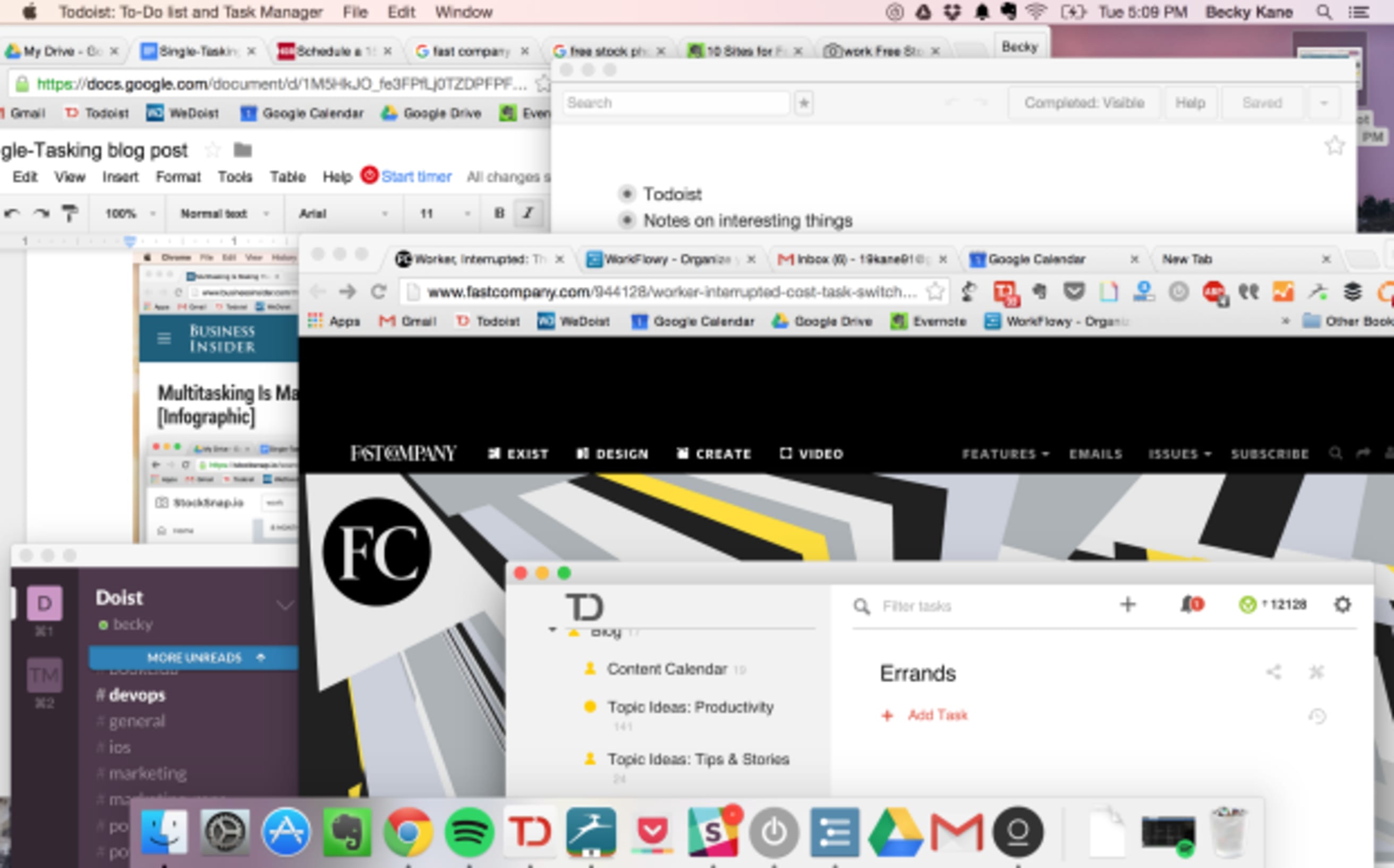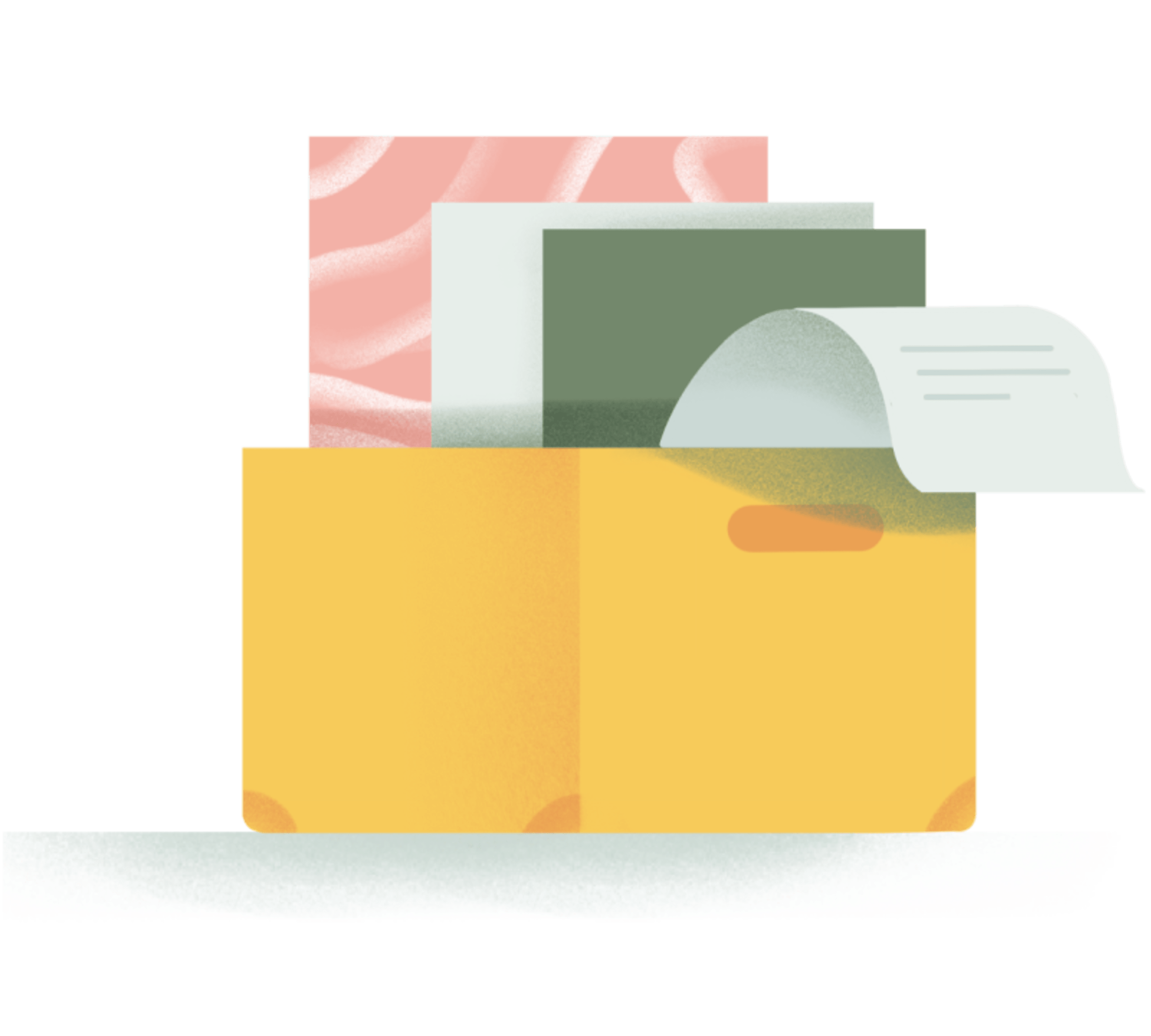The science is in and the results are undeniably bleak:
Context switching — constantly shifting your attention from one app, screen, or task to another — is to your productivity what smoking is to your health.
Here are just a few of the unsettling statistics:
- Trying to focus on more than one thing at a time reduces your productivity by as much as 40%. That’s the cognitive equivalent of pulling an all-nighter.
- The average desk job employee loses 2.1 hours a day to distractions and interruptions. That adds up to over a full day of work every week.
- On average, employees who do the majority of their work on computers are distracted every 10.5 minutes.
- Being distracted by incoming calls or emails can lower employees’ IQ by as much 10 points.
Luckily, it’s not all bad news. 44% of those work distractions are self-inflicted and another 23% come from emails.
That means you have complete control to cut out (or at least drastically reduce) 67% of the productivity-killing distractions that derail your entire workday.
The number one skill that will set you apart from 99% of the world’s highly distractible knowledge workers is the ability to ruthlessly single-task. Here’s why:

What your desktop should not look like.
1) When you work on one thing at a time, you tend to work on the right things. Effective single-tasking requires planning. Starting your day without a plan is just asking for distraction and inefficiency. When you sit down in the morning, or better yet the night before, to plan our your to-do list it forces you to prioritize and consider what tasks will have the highest impact on your work. Instead of getting lost in the never-ending weeds of seemingly urgent, yet ultimately unimportant busy work. In short, you’ll be someone who moves the needle important projects.
2) When you single-task you accomplish more in less time with less stress. We’ve already reviewed the sobering statistics on multi-tasking. Intentionally focusing on one task at a time has been proven the most efficient way to move through your to-do list. It also lowers feelings of stress, frustration, and feelings of perceived effort. The bottom line is that working through your to-do list one task at a time is an effective way to become a happier, more productive employee.
How to build a rock-solid single-tasking habit
I’m not going to lie to you, single-tasking is hard. I certainly haven’t mastered the art of it and it would appear that there aren’t any magical shortcuts (but don’t worry, I’ll keep looking).
In the meantime, here’s what I’m 99% sure is the most complete list of single-tasking strategies available on the Internet (if someone finds a better list, please share it with me!). These strategies are not mutually exclusive and are actually most effective when used together to bolster your single-tasking efforts. They’re organized into the 4 essential components of effective single-tasking:
- Cutting out distractions.
- Make a single-tasking plan you’ll actually stick to.
- Dealing with unavoidable distractions.
- Getting back on track when you’ve fallen off the single-tasking band wagon.
Cutting out distractions
On average, It takes employees a whopping 23 minutes and 15 seconds to get back to their original task once they are interrupted. The first step to single-tasking is to cut out as many distractions in your workday as possible.
1. Fight apps with more apps.
Trusting yourself to simply avoid the distracting sites you’re in the habit of visiting is a recipe for failure. I speak from experience.
Luckily, there are a number of services out there that will block them for you. Freedom and Anti-Social are both great options for blocking distracting websites for preset periods of time.
2. Turn off notifications.
This is an old piece of advice, but that’s because it’s so effective. Seriously, do it. Try turning off all of your desktop notifications for a week and see the difference in your productivity. I know the quick glance to the upper right-hand corner of your screen seems harmless enough, but the time and mental focus lost in attention-switching even for a second adds up throughout the day.
If the thought of turning your phone on silent gives you palpitations, at least turn on priority notifications. Most phones will allow you to designate certain apps as priority. Some phones will even allow you to automatically switch to and from priority mode at certain times of the day. That way you can cut out unnecessary distractions while making sure you don’t miss anything important.
3. Use two computers.
Todoist’s founder, Amir, swears by using two computers to stay focused. He uses his iPad for everything that is likely to very distracting during the day: namely team and external communication. Then he closes his iPad and does his focused work on his regular computer:
One of the things I noticed I do a lot (especially when presented with hard problems) is to procrastinate by opening my email, opening Hacker News or something similar. One way I’ve found to fix this is to have two computers. One computer is where I do work and productive things. Unproductive things are blocked on this computer. I have another computer (an iPad) where I do unproductive work, such as check Hacker News, Facebook etc.
4. Only keep one tab open at time.
This is a simple, yet effective work strategy that Buffer co-founder Leo Widuch uses to stay focused and efficient during the day. Single-tabbing raises the barrier to task switching since you’ll have to close what you’re currently working on in order to start working on something else. It’s a concrete way to make sure that you’re only working on what you intentionally decided to be working on.
5. Use separate desktop spaces.
Now that I’ve told you to single-tab, I have to be honest. While I love the idea, I’ve never been able to get the habit to stick very well. I’ve decided to go with the perhaps less effective, but much more realistic (for me) strategy of using multiple desktops on my laptop to keep my tasks separated.
I limit myself to four desktops only: one for communication windows (Gmail, Slack, Todoist, Sunrise Calendar) and the other three for the windows associated with different projects I plan to work on that day. I add a different background to each desktop so I know exactly which task I’m focusing on at any given time. I’ve found that this decreases the likelihood that I’ll switch tasks mid-way into working on something else.
6. Work offline whenever possible.
I know that for much of the time, working on our computers is synonymous with working online. That said, whenever you do have a task that doesn’t require the Internet, no good can come from staying connected. I’ve dropped the time it takes me to write a blog post by half by simply turning off the wifi while I work on my first draft.
7. Schedule your email time.
When used wisely, email is probably the greatest productivity tool since fire. When used carelessly, it’s a Pandora’s box of distractions just waiting to derail your day. But it can be tamed.
Schedule specific blocks of time into your day to deal with your email. I find checking it just twice a day at 11am and 4:30pm works best for me. It usually takes me between 15-30 minutes to get down to inbox zero each time. During your scheduled email time, follow David Allen’s 2-minute rule: Handle any emails that will take 2-minutes or less. Add everything else to your to-do list to focus on later.
Making a single-tasking plan you’ll actually stick to
In order to single-task effectively, you need to know what it is exactly that you want to be working on. During the day, you should never have to ask yourself the question “What should I work on next?”.
8. Keep a to-do list with focused, actionable items
Make time either first thing in the morning or at the end of the work day to consider your current projects and identify the next concrete task you need to complete to move things forward. Add that task to your to-do list. While a daily review requires a time investment up front, it will pay huge dividends throughout the day as you single-task your way through your list.
9. Visualize your to-do’s one at a time.
When you’re single-tasking, it helps to only see one task at a time. One simple, way to do this is to transfer your to-do’s from your task manager onto post-it notes when you’re planning out your day. Use one post-it per task and keep them in the order you’ll do them. When you’ve completed your task, just remove it and start working on the next one. (HT to the Crew Blog for this incredibly effective trick.)
I like to move my “to-done” post-its to the corner of my desk to visualize how much I’ve accomplished during the day. Seeing progress helps me feel motivated during the post-lunch productivity doldrums.
10. Schedule your daily to-do’s.
Another way to stay focused on one task at a time is to schedule your to-do’s on your calendar. Each task gets a specific time slot when you’ll only work on that one item on your list. That way you’ll know exactly what to give your full attention to at any given point throughout your day.
11. Create unrealistically short deadlines.
Giving yourself less time to complete tasks forces you to stay focused. As leadership expert Peter Bergman put it in an HBR article on his own experiments with single-tasking:
There’s nothing like a deadline to keep things moving. And when things are moving fast, we can’t help but focus on them. How many people run a race while texting? If you really only have 30 minutes to finish a presentation you thought would take an hour, are you really going to answer an interrupting call?
12. Keep a timer on your tasks.
Timesheets have a bad rap for being a pain, but they can actually be a powerful single-tasking tool whether or not you bill your time hourly. Tracking how you spend your time at work forces you to commit to one task at a time.
There are a number of great time-tracking software out there. I recommend using Toggl because their simple desktop app and handy Chrome extension make it easily accessible and they have integrations with the other productivity tools I use most like Google Docs and Todoist.
13. Theme your days.
Most of us have multiple projects and areas of responsibility we have to manage at the same time. It’s difficult to stay focused when you’re switching between several different kinds of tasks for any number of projects throughout the day. One way to single-task your way through multiple concurrent projects is to theme your days. Productivity consultant Mike Vardy uses this technique to prioritize his daily tasks:
One of the best things I ever did to make sure I stayed on top of all of what I had going on was to assign each of the days of the week a general theme. By doing this, I gave my mind clues as to what to place precedence on each day before I even have to look at my to do list. So instead of my mind asking a loaded question (“What do I have to do today?”) it now asks a question that has fewer possibilities by default (“It’s Monday, so it’s Blogging Day. What tasks do I need/want to do that fall under that theme?”).
Dealing with interruptions
No matter how disciplined you are in cutting out distractions and planning out your day, unexpected things are bound to come up. Here are a few strategies to make sure those interruptions don’t throw off the rest of your day:
14. Procrastinate on purpose.
Research shows that employees handle 73% of interruptions immediately, whether the task is time-sensitive or not. While some interruptions are unavoidable, you can limit their impact on your productivity by simply adding them to your to-do list to come back to later.
15. Keep a “read later” list.
One of the self-interruptions I struggle with the most is reading interesting or helpful articles that I inevitably come across while looking for something else online.
Fortunately, this type of distraction has a simple antidote. Whenever you come across a tempting article, save it for later. There are several Chrome extensions that will you allow you to do this in a matter of seconds. I use a combination of Pocket, Evernote, and Todoist. All of these tools have browser extensions that will allow you to save the article and add tags based on subject so you’ll remember to come back to them later.
16. Keep a “bright ideas” repository.
Have you ever racked your brain for a solution to a tricky problem, only to have the answer pop into your head when you weren’t even thinking about it? Our brains tend to make connections at the least likely moments when we’re focusing on something else. However, if we take the time to follow up on each idea the moment it occurs to us, we’ll never get anything done.
Instead of following up on your ideas immediately, keep a running list of thoughts you want to come back to later. There are any number of note-taking and list apps that allow you to jot things down quickly. I use a mix of Todoist and pen and paper to capture thoughts and ideas that I want to revisit later.
17. Set aside exploratory time.
Your “read later” and “bright ideas” lists will only be effective if you actually make the time to go back and review them. Unfocused, agenda-free thinking time is essential for creativity and professional development. If we’re heads-down getting things done all the time, we may miss opportunities and lose track of the big picture.
Alex Turnbill, founder of the customer service software Groove, explains why he schedules time in his calendar for learning:
What I’d recommend is to schedule blocks of time in your calendar for reading. If you see an interesting post outside of that time, bookmark it and return to it at the time you’ve blocked off. This turns reading from a potentially endless time-suck into a carefully managed “task”, just like meetings, writing or anything else you do for your business.
Getting back on track
There will inevitably be days when the temptation to multi-tasking gets the better of you. Don’t panic! Here are two ways to get your focus back:
18. Take regular breaks throughout the day.
Our brains simply did not evolve to focus on one thing for extended periods of time. Studies have shown that the longer we work without the breaks, the more prone to distraction we become. As one HBR article explains the benefits of scheduling regular breaks to refocus on the task at hand:
When you work on a task continuously, it’s easy to lose focus and get lost in the weeds. In contrast, following a brief intermission, picking up where you left off forces you to take a few seconds to think globally about what you’re ultimately trying to achieve. It’s a practice that encourages us to stay mindful of our objectives, and, as the authors of the study report, reliably contributes to better performance.
19. Forgive yourself when your day doesn’t go as planned.
Those of you who follow the blog will probably think I’m a broken record on this one, but I’m going to repeat it because I think it’s that important:
When your day hasn’t gone right and you’ve succumbed to the temptations of multitasking and you leave the work day with most of your to-do’s unchecked, give yourself permission to just let it go. Ruminating on the past one of the least productive things you can do. Research suggests that practicing self-compassion when you haven’t accomplished as much as you want to actually corresponded with more productive behaviors on similar tasks in the future.
Even to the most productive of us have less-than-productive days (or so I would like to think). Forgive yourself and redouble your resolve to put the single-tasking strategies you learned in this post into practice tomorrow.
The tl;dr summary of your single-tasking game plan:
- Cut out distractions. Use Freedom or another service to block distracting sites, turn off all of your notifications, and schedule your email time.
- Make a single-tasking plan each and every day. You should never have to ask yourself, "what should I work on next?" in the middle of your work day. Write down your to-do’s on sticky notes or schedule them in your calendar.
- Limit self-interruptions. Save interesting articles and jot down any ideas that come to you while working on something else. Set aside unstructured time during the day or week to review these lists.
- Get back on track. Schedule regular breaks into your day to re-focus. Forgive yourself when your day gets derailed by distractions; focus on what you’ll do differently tomorrow instead.

